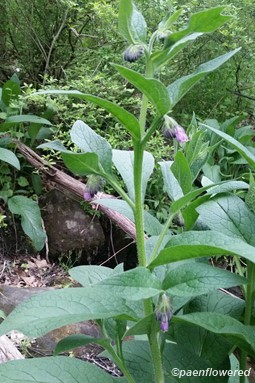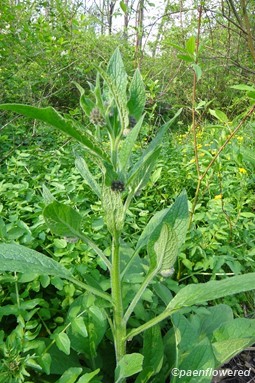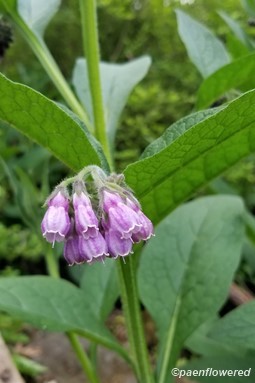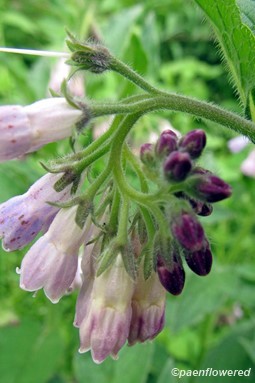Symphytum officinale
A naturalized cultivated plant with bell-like purplish flowers
Symphytum officinale common comfrey
This European perennial wildflower is a member of the forget-me-not family and is native to Europe and southwestern Asia. It is now widely naturalized in North America and around the world. It is a branching hairy plant. A cluster of white, cream, pink, purple or blue tubular or bell-shaped flowers hang down from an uncoiling flower stalk. Velvety calyx scales embrace the base of each flower. Bumblebees are frequent visitors to the flowers.
The fruit that forms is flattened and covered with hooked spines. These adhere to fur or clothing. The plant grows 2-4 feet high and 2.5 feet wide and is found on roadsides, in pastures, and in waste places where it is damp and partially shaded. The large heavily veined lance-shaped leaves flow gradually into the winged stem. It has both basal and stem leaves, though the stem leaves are smaller.
This species is found throughout the United States except for the deep south, the great plains and the desert southwest. The USDA documents it in Washington, Greene, Allegheny, Westmoreland, Blair, Crawford, Warren and Jefferson Counties, but it certainly is more widespread as I have seen it growing in Beaver County. The flowers bloom from May to September. Comfrey can be grown as a garden ornamental. Once established, it can be difficult to eliminate, because even a fragment of its tuberous root can generate a new plant. In areas where it is abundant, it is often considered a noxious weed.
The plant has long been used in Europe for food and as a medicinal herb for healing wounds and broken bones, but this plant is a good example of why using herbal medicines should be done with caution. The roots and older leaves contain an alkaloid toxin, and many experts caution that, if taken internally, extracts of this plant could cause liver damage. Currently, much of the commercially available comfrey for internal use is homeopathic, and thus plant chemicals are highly diluted almost to the point of not being present. This makes it harmless but of doubtful medical value. Use of extracts of comfrey in an ointment form seems harmless, but again the medical value has yet to be experimentally documented. This plant is also commonly called knitbone because of one of its previous herbal uses.
Habitat & Range
Cultivated and occasionally naturalized in fields, roadsides, and waste grounds.
Scattered throughout the state.
Range: Throughout United States
Wetland code: Not classified
Phenology
Flowers June to August.







Comments
Have you spotted this plant in your area? We'd love to hear about your experience! Share your comments or questions about the plant below. Comments are moderated before posting.